
Jie Han

Jie Han
I am the Principal Investigator (PI) of the Environmental and Public Health Group and a Professor with a 'Young Talent Tier A' appointment at Xi'an Jiaotong University (XJTU), member of the 'C9 league' universities in China, which is ranked among the top 10 in science and engineering in the country.
The overall theme of my research is on environment and public health, and much of my previous work was on emerging contaminants, particularly the migration of trace organic compounds into and out of polymers including membranes, common plastics, and elastomers. I have strong interests in advancing public health including exposure identification, risk assessment, mitigation, and science communication to the general public.
Prior to joining XJTU, I received research training and experience from the University of Auckland (UoA), National University of Singapore (NUS), University of Illinois at Urbana Champaign (UIUC), and University of Massachusetts Amherst (UMass Amherst), and worked with the PIs of several world-renowned laboratories in my fields. Since my Auckland times, I have supervised over 50 students, including undergraduates and Master's students who later developed strong interests in scientific research and pursued their PhDs. In the past six years, I have delivered over a dozen research projects as the PI or co-PI, and received over eight million RMB in research funding.
I have a strong passion in scientific writing, editing, and communication. I hold appointments as the Co-Editor-in-Chief of Environmental Chemistry Letters (Springer Nature, JCR Q1, IF 15.0) and I am a member of the Editorial Board of Chemical Engineering Journal (JCR Q1, IF 13.3), Ecotoxicology and Environmental Safety (JCR Q1, IF 6.8), and Animal Diseases (a new journal launched in spring 2021, indexed by ESCI). I serve as a member of the Council of Science Editors (U.S.) and the China Editology Society of Science Periodicals. I am a Senior Member of the Chinese Society for Enviornmental Sciences and hold long-term memberships of the International Water Association (IWA) and the American Chemical Society (ACS).

To me, the whole idea of ‘Planetary Environmental Engineering’ started in 2016. I first brought up this idea with my research associate in 2019. And again in May 2021, when a student came over, with excitement in her eyes, and talked about 'space debris'.
The first time I read about 'terraforming’, I found it mind blowing. The whole idea kept me excited for the rest of that day, and I read nothing else but that, for a few hours straight. Those who thought about this idea were true pioneers of the humankind. I’m deeply humbled by their vision and imagination.
I feel now it is the time for us to, at least, start our conversations on this futuristic yet deeply intriguing topic.
Here is a collection of our thoughts and ideas, in no particular order. As of now, we don’t have anything published yet, but we are hoping to do so over the next few months.
Let’s start from space debris (space junk).
***
If aliens want to visit earth, they would have to go through our trashes first.
We live in an era where humans can ‘engineer’ just about anything. The term ‘environmental engineering’, literally, means crafting a desirable environment for humans to live in. The most sophisticated task for environmental engineers, therefore, is to build a new ecosystem on a new planet, for humans to live in.
Environmental engineering may, one day, take the central stage of all engineering disciplines because it - once we take it to the space - enables humans to take possession of one thing that they have thirsted and fought each other for thousands of years – new land.
Environmental engineers have spent much efforts on remediating, but much less on creating. Terraforming is the future – and perhaps the ultimate – goal of studying environmental engineering.
Why do we have to accept the fact that Earth is our *only* home? The whole universe is out there for human exploration.
Terraforming isn't about finding a new planet and abandoning our junk-filled earth, or having a backup if earth is destroyed or becomes inhabitable. It's about finding some other interesting places to go. Earth is great and we humans can keep it great.
Here is the question we hope to answer through Planetary Environment Engineering: Can we install a new ecological system on a new planet for human habitation?
If the earliest life forms on earth were microbes, can we engineer some hardcore microbes and seed them all over Mars to terraform the planet?
Engineering an ecosystem on a new planet may prove more realistic than finding an earth-like planet in a distant galaxy. The universe is mind-blowingly vast: we either have to find some 'wormholes' or travel near the speed of light just to get there.
Let's hope we don't need a visa to go to Mars.

刘丽平 等. 太空旅行元年:是时候评估太空垃圾对地球环境的影响

(Preprint version) Dawn of space tourism: It is time to address the environmental impact of anthropogenic debris upon above earth. Available from SSRN. https://dx.doi.org/10.2139/ssrn.3979481 (Date Written: 21 October 2021) PDF download
(Published verision) Space industrialization. Environmental Chemistry Letters. https://doi.org/10.1007/s10311-022-01411-2 (Published 21 February 2022) (JCR Q1, IF 15.7)
【更新】美国电信和信息管理局(NTIA)2 月 8 日代表美国航空航天局(NASA)致信美国联邦通信委员会(FCC),要求就美国 SpaceX 公司规划的第二代星链(Starlink Gen 2)卫星星座的卫星数量问题进行协调和沟通。第二代星链规划中的近地轨道卫星约有 3 万颗,NASA 在信函中阐述了对星链负面影响的忧虑:星链将使近地轨道物体数量增加至 5 倍以上。
Work by early pioneers & recent debates (in chronological order):
Planetary Engineering on Mars. Icarus, 20, 513-514 (1973) https://doi.org/10.1016/0019-1035(73)90026-2
Seeking a new home: some thoughts on the longer term trends in planetary environmental engineering. Environmentalist, 20, 191–194 (2000). https://doi.org/10.1023/A:1006768412363
The biological terraforming of Mars: Planetary ecosynthesis as ecological succession on a global scale. Astrobiology, 4, 168-195 (2004) https://doi.org/10.1089/153110704323175133
An Ecological Compass for Planetary Engineering. Astrobiology, 12, 985–997 (2012). https://doi.org/10.1089/ast.2011.0796
Inventory of CO2 available for terraforming Mars. Nature Astronomy, 2, 634–639 (2018). https://doi.org/10.1038/s41550-018-0529-6
Reimagining terraforming, Nature Astronomy 3, 883-884 (2019). https://doi.org/10.1038/s41550-019-0908-7
Enabling Martian habitability with silica aerogel via the solid-state greenhouse effect. Nature Astronomy 3, 898–903 (2019) https://doi.org/10.1038/s41550-019-0813-0